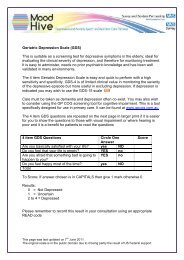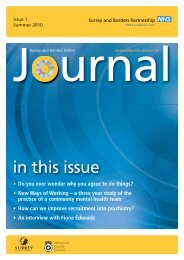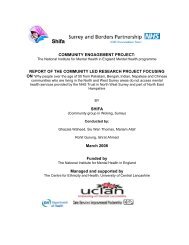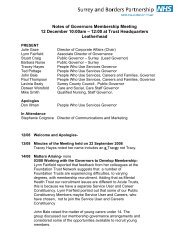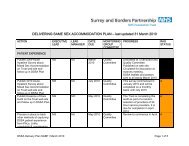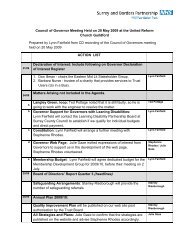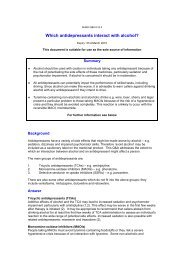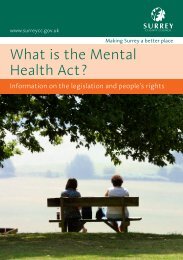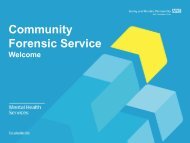Medicines Q&As
Medicines Q&As
Medicines Q&As
You also want an ePaper? Increase the reach of your titles
YUMPU automatically turns print PDFs into web optimized ePapers that Google loves.
<strong>Medicines</strong> Q&<strong>As</strong><br />
Doxepin is considered to have the lowest incidence of seizures (5;7;9;21) and therefore is considered<br />
the TCA of choice. The manufacturers of amitriptyline and clomipramine have advised that these<br />
antidepressants should be used with caution in epilepsy but other sources recommend that they<br />
should be avoided completely in epilepsy (22).<br />
Selective Serotonin Reuptake Inhibitors (SSRIs)<br />
In general, the SSRIs have been suggested to have a low pro-convulsive effect (7;22), a favourable<br />
side effect profile and to be less problematic in overdose (6). SSRIs are associated with a lower<br />
incidence of seizures when compared with TC<strong>As</strong> (1;11). However, little data are available<br />
concerning the use of SSRIs in patients with epilepsy. Early clinical trials suggested that the SSRIs<br />
were not associated with seizures (6). Seizures have now been reported with all SSRIs (16) and the<br />
risk is considered to be dose related (22). Data on how these antidepressants induce seizures is still<br />
controversial, one theory is that a decreased turnover of serotonin in the central nervous system<br />
(CNS) might be associated with seizures (23). There is some evidence that SSRIs increase the<br />
seizure duration once a seizure has commenced (6).<br />
Fluoxetine is the most studied SSRI and was suggested to exert an anticonvulsant effect in rats, this<br />
has been further supported by data from small-scale controlled studies in humans (23). Fluoxetine<br />
has a probable seizure incidence of 0.2% (7;11;16) and has a long half-life (24). The manufacturers<br />
recommend it should be avoided in patients with unstable seizure disorders and patients with<br />
controlled epilepsy should be monitored (24).<br />
One small-scale study (n=28) reported that fluvoxamine was not epileptogenic at doses ranging from<br />
50 to 200mg, when given to depressed epileptic patients (25) however there have been case reports<br />
of seizures following therapeutic doses of fluvoxamine in patients with and without a previous history<br />
of seizures (26). More recently, a retrospective survey of prescriptions (n=10,401) suggested the<br />
incidence of seizure with fluvoxamine to be 0.2% in the general population (27). It has also been<br />
suggested that fluvoxamine is associated with a higher incidence of seizures in overdose when<br />
compared to other SSRIs but the evidence for this is poor (6). Fluvoxamine should be avoided in<br />
patients with unstable epilepsy and patients with controlled epilepsy should be carefully monitored<br />
(28).<br />
Paroxetine appears to have a minimal potential for producing seizures at therapeutic doses (7) but<br />
the manufacturers suggest that it should be used with caution in patients with epilepsy (29). Reviews<br />
suggest paroxetine has a seizure incidence of 0.1% (6;11;30). Seizures have occurred rarely in trials<br />
and no cause-effect relationship has been proven (7).<br />
Citalopram and escitalopram have not been reported to have a pro-convulsive effect (7). In a recent<br />
open label study citalopram 20mg/day was associated with an improvement in depressive symptoms<br />
and a reduction in seizure frequency in 39 patients who had epilepsy and depression (31). A study of<br />
43 patients with epilepsy showed citalopram to be an effective antidepressant without affecting<br />
seizure frequency (32). It is considered one of the first line options due to it is perceived safety in<br />
these patients and lack of interactions with the anticonvulsant agents (11;22) .<br />
Early clinical trials with sertraline suggested that seizures occurred at a similar frequency to placebo<br />
and only in people with a history of seizures (7). The above study in 43 patients showed only 6% of<br />
epileptics taking sertraline had worsening of seizures, which were corrected by adjusting the<br />
antiepileptic dosage (4;32).<br />
Overall, it has been suggested that the risk of seizures with SSRIs at therapeutic doses lies between<br />
0.1-4% (23) but the incidence varies between individual agents. SSRIs are considered the first line<br />
antidepressant option in patients with epilepsy (3;4;11;22;27). Fluoxetine, fluvoxamine and paroxetine<br />
are all potent inhibitors of the cytochrome P450 enzymes (11;22), which means they have interaction<br />
potential with the anticonvulsant agents, which needs to be considered. Citalopram and sertraline<br />
may be considered the safest options due to their lack of interaction potential with the anticonvulsants<br />
(11). The manufacturers of these agents recommend to avoid their use in patients with unstable<br />
epilepsy (33;34).<br />
From the National Electronic Library for <strong>Medicines</strong>. www.nelm.nhs.uk 2



